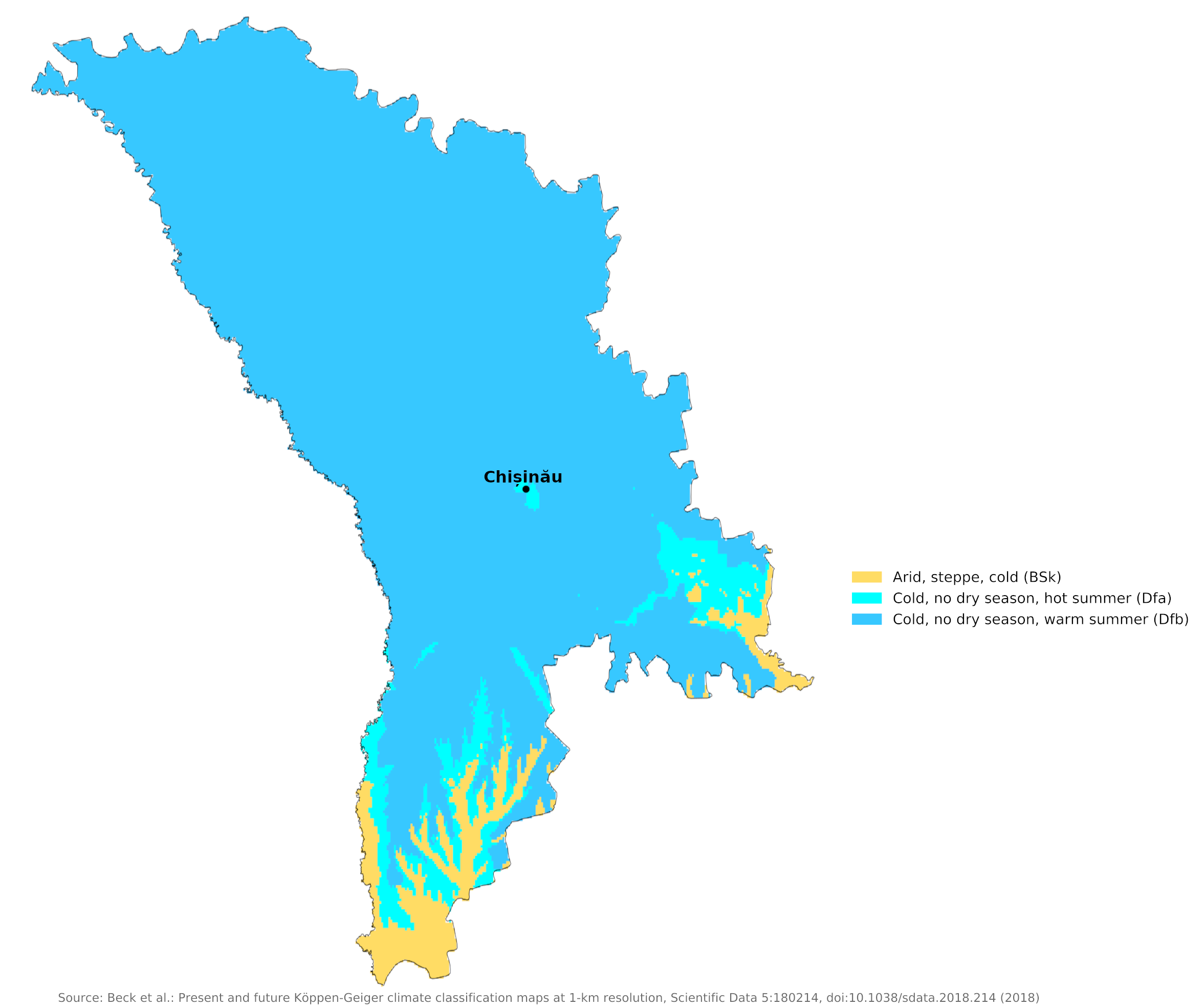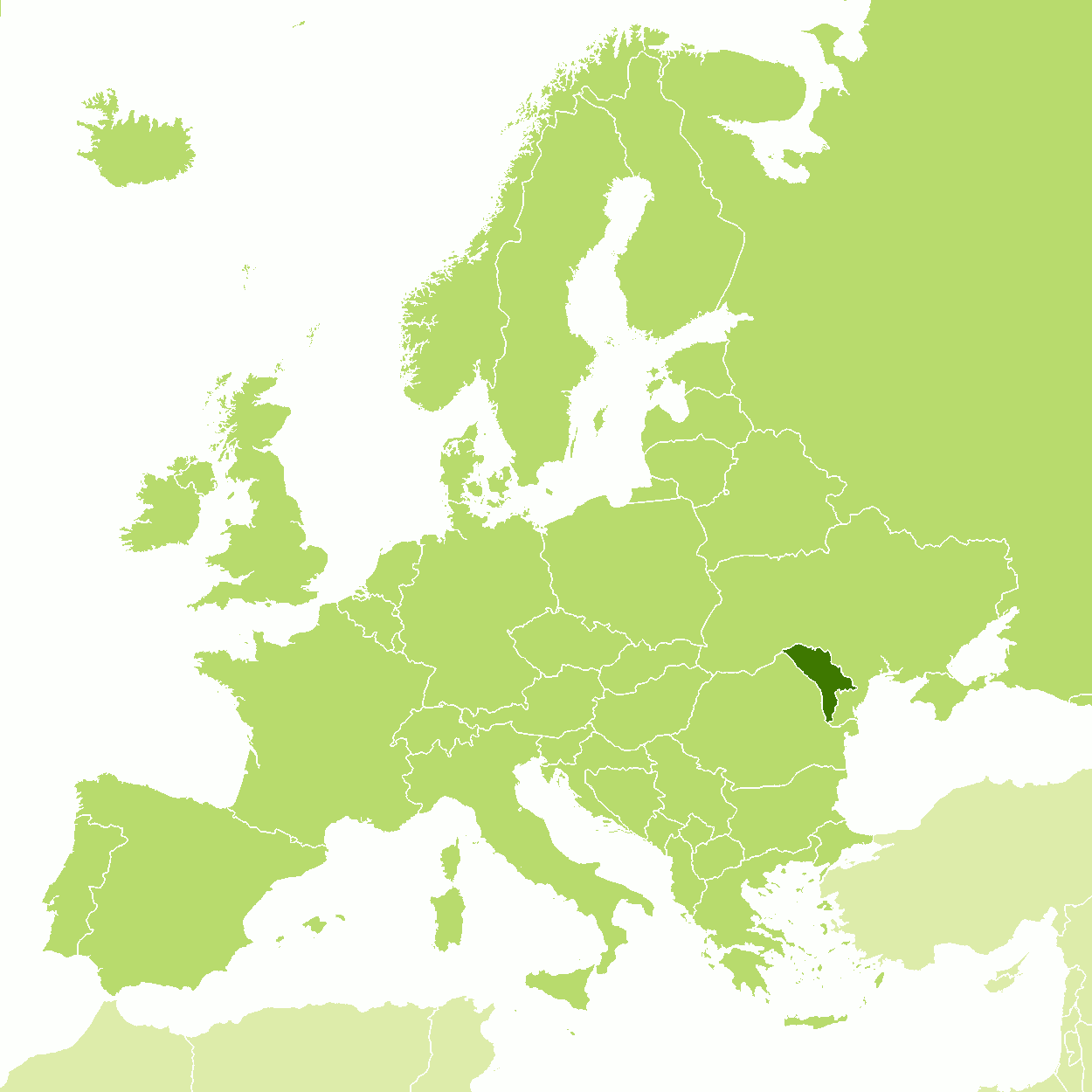The Climate of
Moldova
.jpg) Stephen the Great Monument, Chișinău
Stephen the Great Monument, Chișinău
Climate Map
 Climate map of Moldova
Climate map of Moldova
What is the climate of Moldova like?
Moldova is a landlocked nation located in eastern Europe. It shares boundaries with Ukraine on the east and Romania on the west. The Moldovan climate is moderately continental, with conditions kept somewhat stable by the influence of the Black Sea. The country is exposed to northerly cold winds in the winter and moderate westerly winds in the summer.
Although the winters are cold in Moldova and spells of extremely cold weather occur when easterly winds blow from Siberia, the winter is shorter than in northern areas of neighbouring Ukraine and Romania, and the spring thaw comes earlier. Winters are generally dry, with average daily temperatures in January ranging from –5°C to –2°C (23°F to 28°F). The summers summers are warm and long; average daily temperatures in July exceed 20°C (68°F), and record highs even reach 40°C (104°F).
Rainfall in Moldova is typically light and sometimes irregular. Rainfall is lightest in the south, on average 350 millimeters (14 inches) per year. At higher elevations, it can exceed 600 millimeters (20 inches). The rainfall can vary greatly; long dry spells are not unusual. The heaviest rainfall occurs in early summer, and heavy showers and thunderstorms are common. Because of the irregular terrain, heavy summer rains often cause erosion and river silting.
Chișinău is representative of weather in Moldova.
| Climate data for Chișinău (1991–2020) | |||||||||||||
|---|---|---|---|---|---|---|---|---|---|---|---|---|---|
| Month | Jan | Feb | Mar | Apr | May | Jun | Jul | Aug | Sep | Oct | Nov | Dec | Year |
| Average high °C (°F) | 1.1 (34.0) | 3.4 (38.1) | 9.2 (48.6) | 16.4 (61.5) | 22.3 (72.1) | 26.1 (79.0) | 28.4 (83.1) | 28.3 (82.9) | 22.3 (72.1) | 15.5 (59.9) | 8.1 (46.6) | 2.7 (36.9) | 15.3 (59.5) |
| Daily mean °C (°F) | −1.8 (28.8) | −0.2 (31.6) | 4.5 (40.1) | 11.0 (51.8) | 16.8 (62.2) | 20.7 (69.3) | 22.9 (73.2) | 22.6 (72.7) | 17.0 (62.6) | 10.8 (51.4) | 4.8 (40.6) | −0.2 (31.6) | 10.7 (51.3) |
| Average low °C (°F) | −4.2 (24.4) | −3.0 (26.6) | 0.7 (33.3) | 6.3 (43.3) | 11.8 (53.2) | 15.9 (60.6) | 17.9 (64.2) | 17.5 (63.5) | 12.5 (54.5) | 7.1 (44.8) | 2.1 (35.8) | −2.5 (27.5) | 6.8 (44.2) |
| Average precipitation mm (inches) | 36 (1.4) | 31 (1.2) | 35 (1.4) | 39 (1.5) | 54 (2.1) | 65 (2.6) | 67 (2.6) | 49 (1.9) | 48 (1.9) | 47 (1.9) | 43 (1.7) | 41 (1.6) | 555 (21.9) |
| Average extreme snow depth cm (inches) | 7 (2.8) | 6 (2.4) | 3 (1.2) | 0 (0) | 0 (0) | 0 (0) | 0 (0) | 0 (0) | 0 (0) | 0 (0) | 1 (0.4) | 3 (1.2) | 20 (7.9) |
| Source: www.pogodaiklimat.ru | |||||||||||||
References
- E. A. Pearce, Charles Gordon Smith, (1990) The Hutchinson World Weather Guide, John Murray Press. ISBN 1859863426
- Timothy L. Gall, (ed.), (2003), Worldmark Encyclopedia of the Nations, Eleventh Edition, Thomson Gale
- Federal Research Division, Library of Congress, (1995), Belarus and Moldova: country studies. Claitor's Pub. Division. ISBN 0844408492
- Hugh Chisholm, (ed.), (1911), Encyclopædia Britannica, Eleventh edition, Cambridge University Press
The Climate of
Moldova

In summary:
The climate of Moldova is a humid continental type. The country is exposed to northerly cold winds in the winter and moderate westerly winds in the summer. The average temperature in July is 23°C (73F). The average temperature in January is -2°C (28°F). Rainfall averages 560 mm (22 in) a year.